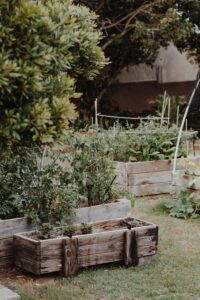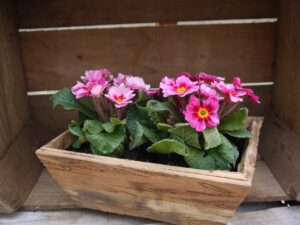In today’s fast-paced world, finding the time to care for our beloved plants can often be daunting. That’s where self-watering planters come to the rescue! These ingenious creations save you the hassle of constantly watering your plants and ensure your leafy friends receive the right amount of hydration they need to thrive. But with various options available, how do you choose the perfect self-watering planter? Fear not, as we guide you through the process, helping you find the ideal planter to keep your plants happy and healthy effortlessly.
Materials and Durability
When choosing a self-watering planter, one of the most important factors to consider is the material it is made of. Different materials offer varying levels of durability, aesthetics, and weather resistance. Common materials for self-watering planters include plastic, ceramic, and metal.
Choosing the Right Material
Plastic self-watering planters are lightweight and affordable. They are easy to move around and come in various colors and designs. However, they may not be as durable as other materials and may fade or crack over time.
Ceramic self-watering planters are known for their elegant and timeless look. They are often handcrafted, adding a touch of sophistication to any space. However, ceramic planters can be heavy and may break if mishandled.
Metal self-watering planters like stainless steel or galvanized iron are highly durable and weather-resistant. They can withstand harsh outdoor conditions without rusting or corroding. However, metal planters can be more expensive and may not have as many design options as plastic or ceramic.
Checking the Durability
Regardless of the material chosen, it is essential to check the durability of the self-watering planter. Look for a sturdy and well-constructed planter. It should withstand the weight of the soil and plants without bending or warping. Additionally, inspect the seams or joints to ensure they are securely fastened.
Considering Weather Resistance
If you plan to place your self-watering planter outdoors, it is crucial to consider its weather resistance. Look for planters that are UV-resistant and capable of withstanding extreme temperatures. This will ensure that your planter will maintain its appearance and functionality over time, regardless of the weather conditions it is exposed to.
Size and Capacity
The size and capacity of a self-watering planter are essential factors to consider when choosing the right one for your plants. Matching the planter’s size and capacity with your plant’s needs and the available space is essential.
Determining Plant Size
Consider your plants’ mature size and choose a self-watering planter that can accommodate their growth. Large plants with extensive root systems require a more profound and broader planter, while smaller plants may thrive in more compact options.
Considering Available Space
Before purchasing a self-watering planter, measure the space where you plan to display it. Consider the floor or ground space and any height restrictions, if applicable. This will help you choose a planter that fits perfectly and enhances the overall aesthetic of your space.
Matching Planter Capacity
Another important consideration is the capacity of the self-watering planter’s water reservoir. Depending on the type of plants you choose and the frequency at which you can water them, you will need a planter with an appropriately sized reservoir. Larger reservoirs can hold more water and provide more extended periods of self-watering, making them ideal for busy individuals or those who travel frequently.
Design and Aesthetics
Self-watering planters come in various styles, colors, and designs, allowing you to find one that perfectly matches your personal preferences and existing decor. Consider the following factors when choosing the design and aesthetics of your self-watering planter.
Choosing a Style
Consider your style and the overall aesthetic you want to achieve in your space. Self-watering planters come in various styles, from sleek and modern to rustic and traditional. Choose a style that complements your decor or makes a statement as a focal point.
Considering Indoor or Outdoor Use
Different environments call for various types of self-watering planters. If you plan to place your planter indoors, choose a design and material that will integrate seamlessly with your indoor decor. If you plan to use the planter outdoors, opt for weather-resistant materials and styles that can withstand exposure to the elements.
Matching Planter with Existing Decor
Take the time to consider the colors, patterns, and materials already present in your space. Look for a self-watering planter that complements or enhances the existing decor. A well-chosen planter can add a pop of color or provide a stylish accent, tying the overall design together.
Watering System
The watering system of a self-watering planter is what sets it apart from traditional planters. Understanding the mechanisms, reservoir capacities, and drainage systems will help ensure optimal plant health and water management.
Understanding Self-Watering Mechanisms
Self-watering planters employ various mechanisms to provide water to plants as needed. The most common mechanism involves a water reservoir at the bottom of the planter, which is connected to a wicking system. The plants draw water from the reservoir through capillary action, ensuring they receive the perfect amount of moisture.
Evaluating Water Reservoir Capacity
The water reservoir capacity is an essential factor to consider when choosing a self-watering planter. It determines how long your plants can go between waterings and how often you must refill the reservoir. When selecting a planter with an appropriate reservoir capacity, consider the size of your plants, their water requirements, and the amount of time you can dedicate to plant care.
Considering Drainage System
While self-watering planters are designed to provide plants with the right amount of moisture, proper drainage is still essential. Excess water should be able to drain out of the planter to prevent overwatering and root rot. Look for self-watering planters with built-in drainage systems, allowing excess water to escape while maintaining the reservoir.
Maintenance and Ease of Use
A self-watering planter should provide convenience and be easy to maintain. Consider the following factors when evaluating the maintenance and ease of use of different self-watering planter options.
Ease of Refilling Water Reservoir
Refilling the water reservoir of your self-watering planter should be simple and straightforward. Look for planters with easy-to-access refill openings or indicators that clearly show when the water level is low. This will make it easier to keep your plants hydrated without hassle.
Checking for Cleaning Accessibility
Regular cleaning is crucial for maintaining the health and vitality of your plants. Choose a self-watering planter that allows easy access to all parts, making cleaning a breeze. Removable parts or easily disassembled components can simplify cleaning and save you valuable time and effort.
Evaluating Overall User-Friendliness
Consider the self-watering planter’s overall user-friendliness. Are the instructions clear and easy to follow? Does the planter have any additional features that enhance its functionality? Evaluate the overall design and features to ensure the planter provides a seamless, hassle-free gardening experience.
Plant Compatibility
Different plants have different growth requirements, so it’s crucial to choose a self-watering planter that can meet those needs. Consider the following factors when assessing plant compatibility.
Considering Plant Types
Not all self-watering planters are suitable for every type of plant. Consider the specific needs of the plants you intend to grow and choose a planter to provide the necessary conditions for their growth. Some plants may require more sunlight, while others thrive in shade. Take these factors into account when selecting a self-watering planter.
Checking Planting Depth
Another important consideration is the planting depth required for your plants. Some plants have shallow root systems and will thrive in planters with shallower depths, while others need more bottomless planters to accommodate their extensive root systems. Ensure the self-watering planter has the appropriate planting depth for your specific plants.
Assessing Required Soil Moisture Levels
Different plants have varying soil moisture requirements. Some prefer drier conditions, while others need consistently moist soil. Ensure that the self-watering planter can provide the necessary moisture levels for your plants’ optimal growth and health.
Price Range
When investing in a self-watering planter, it is essential to determine your budget and compare prices and features to find the best value for your money.
Determining Budget
Set a realistic budget before embarking on your search for the perfect self-watering planter. Consider how many planters you need and how much you will spend on each. This will help you narrow your options and focus on those within your price range.
Comparing Prices and Features
Once you have established your budget, compare the prices and features of self-watering planters within that range. Look for planters that offer the best combination of durability, functionality, and aesthetics for the price. Remember to consider any additional features or warranties that may be included with higher-priced options.
Reviews and Recommendations
Before making a final decision, read customer reviews and seek expert recommendations. This will provide valuable insights into the performance and durability of different self-watering planters.
Reading Customer Reviews
Customer reviews can give you an idea of other individuals’ experiences with a particular self-watering planter. Look for reviews that mention previous buyers’ durability, ease of use, and overall satisfaction. If possible, seek out reviews from customers with needs and preferences. Similar toeyourspert Recommendations
If you are unsure about which self-watering planter to choose, consider seeking recommendations from gardening experts or professionals. They can provide valuable insights and advice based on their experience and knowledge. Whether through online forums, gardening communities, or local gardening centers, expert recommendations can help you make an informed decision.
Extra Features
Some self-watering planters have additional features that enhance their functionality and convenience. Consider the following extra features when selecting a self-watering planter.
Availability of Wheels
Self-watering planters with built-in wheels make it easy to move them around, especially for larger or heavier planters. This feature is particularly convenient if you like to rearrange your plants frequently or need to move them for cleaning or sunlight purposes.
Built-in Planters or Dividers
Specific self-watering planters may have built-in compartments or dividers, allowing you to grow multiple plants in one planter. This feature can be helpful if you have limited space or want to create a visually appealing arrangement with different plant varieties.
Customizable Options
Some self-watering planters offer customizable components, such as adjustable wicks or partition walls. These allow you to tailor the watering system to your plant’s needs and further enhance their growth and health.
Warranty and Customer Support
When investing in a self-watering planter, it is essential to check the warranty terms and assess the level of customer support the manufacturer provides.
Checking Warranty Terms
Look for self-watering planters that come with a warranty. A warranty demonstrates the manufacturer’s confidence in the product’s quality and can provide peace of mind. Carefully read and understand the warranty terms, including any limitations or conditions, to help you make an informed decision.
Assessing Customer Support
Consider the level of customer support offered by the manufacturer. Are they responsive to inquiries or concerns? Is a dedicated customer support team available to assist you with any issues? Good customer support can significantly impact your overall experience with the self-watering planter.



